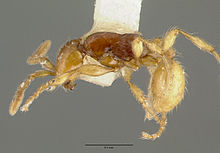Loading AI tools
Species of ant From Wikipedia, the free encyclopedia
Aenictus ceylonicus is a species of reddish brown army ant found in Southern India, Sri Lanka, Southeast Asia and Australia.[1] They are completely blind and around 3 mm in length. These ants are seen foraging underneath leaf litter in forests and well-vegetated areas, travelling in a trail of in three or more columns alongside each other, in parts of India. Their antennae, as in most species of Aenictus, have ten segments. The scape is long and extends above the head. The head is smooth and shiny. The mesosoma and the head region are dark brown, while the gaster is oval and lighter in colour, nearly translucent. The mesosoma is broad anteriorly and strongly compressed posteriorly. The petiole and the post petiole are large, conical and shining.[2] They occur in rainforests and moist deciduous forests building temporary nests on the ground and in rotting logs.[citation needed]
| Aenictus ceylonicus | |
|---|---|
 | |
| Aenictus ceylonicus worker | |
| Scientific classification | |
| Domain: | Eukaryota |
| Kingdom: | Animalia |
| Phylum: | Arthropoda |
| Class: | Insecta |
| Order: | Hymenoptera |
| Family: | Formicidae |
| Genus: | Aenictus |
| Species: | A. ceylonicus |
| Binomial name | |
| Aenictus ceylonicus (Mayr, 1866) | |
Like others in the genus, they prey on ants, social wasps and other arthropods. Some forms of the species such as formosensis of Taiwan were earlier considered separate species.[3]
Seamless Wikipedia browsing. On steroids.
Every time you click a link to Wikipedia, Wiktionary or Wikiquote in your browser's search results, it will show the modern Wikiwand interface.
Wikiwand extension is a five stars, simple, with minimum permission required to keep your browsing private, safe and transparent.